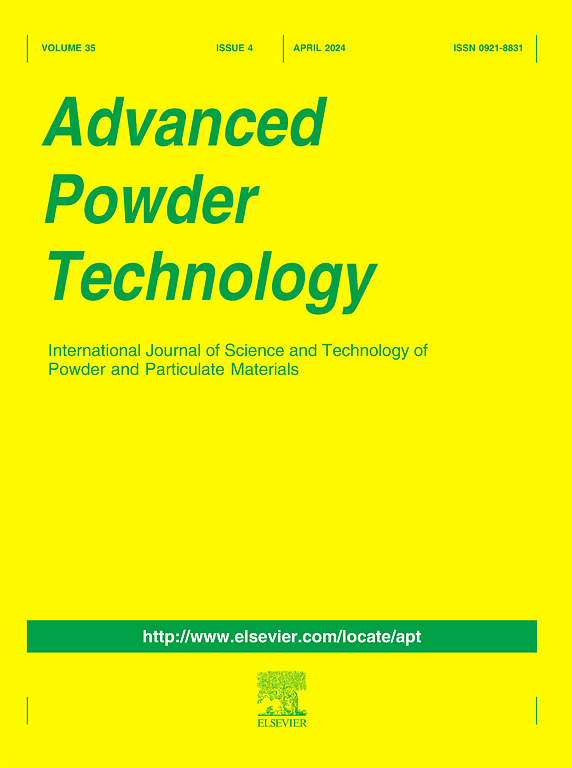A GPU-accelerated CFD-VOF-DEM approach for modelling the wet grinding process in a SAG mill and the mill speed effects
IF 4.2
2区 工程技术
Q2 ENGINEERING, CHEMICAL
引用次数: 0
Abstract
Semi-autogenous grinding (SAG) mills are essential for cost-effective rock beneficiation, primarily utilizing wet milling processes. Although the milling process has been extensively studied by DEM modelling, the effect of slurry is frequently neglected due to its complex interactions with the charge. This paper presents an efficient CPU-GPU framework for CFD-DEM modelling of the gas–liquid-solid flows during the wet grinding in a 34′ SAG mill. The model, which adopts a VOF approach to simulate the free surface between gas and liquid slurry phase, was comprehensively validated across four different cases, including particle sedimentation, phase conservation, and particle dynamics in both dry and wet drums. The validated model was used to simulate multiphase interactions in a SAG mill at various rotation speeds.
The milling process stabilized after 20 s, with the bed showing a kidney shape, characterized by the cascading zone and cataracting stream. The slurry flow, enveloped by the particle bed, exhibited a strong recirculating flow following the particle trajectories. The inclusion of slurry resulted in weaker and fewer particle collisions, with the fluid force accounting for half of the total force acting on particles. The effect of the slurry on rock particles was greater than on ball particles due to the density difference. Power consumption mainly resulted from interactions between the lifter sides and particles, while the slurry consumed minimal power. Both collision energy and frequency significantly increased at higher mill speeds, which are also expected to cause more severe liner wear and increased power consumption.
The model provides an efficient framework for simulating dense particles interacting with multiple fluid phases. The findings elucidate the multiphase interaction mechanisms in the SAG mill and underscore the necessity of including slurry in simulations to accurately model the milling dynamics.

一种gpu加速的CFD-VOF-DEM方法用于模拟SAG磨机湿磨过程和磨机速度效应
半自磨(SAG)磨机对于具有成本效益的岩石选矿至关重要,主要采用湿磨工艺。尽管通过DEM模型对磨矿过程进行了广泛的研究,但由于料浆与料浆之间复杂的相互作用,其影响往往被忽略。本文提出了一种高效的CPU-GPU框架,用于34 ' SAG磨湿磨过程中气液固流动的CFD-DEM建模。该模型采用VOF方法模拟气液浆相之间的自由表面,并在四种不同的情况下进行了全面验证,包括颗粒沉降、相守恒和干湿鼓中的颗粒动力学。将验证的模型用于模拟不同转速下SAG磨内的多相相互作用。铣削过程在20 s后趋于稳定,床层呈肾状,具有级联带和瀑布流的特征。浆料流被颗粒床包裹,表现出沿颗粒轨迹的强再循环流动。浆料的包裹导致颗粒碰撞更弱、更少,流体力占颗粒所受总力的一半。由于密度差,浆液对岩石颗粒的影响大于对球颗粒的影响。动力消耗主要来自提升器侧与颗粒之间的相互作用,而浆体消耗的动力最小。在更高的磨速下,碰撞能量和频率都会显著增加,这也会导致更严重的衬套磨损和功率消耗增加。该模型为模拟致密颗粒与多种流体相的相互作用提供了一个有效的框架。研究结果阐明了SAG磨中的多相相互作用机制,并强调了在模拟中包括浆料以准确模拟磨粉动力学的必要性。
本文章由计算机程序翻译,如有差异,请以英文原文为准。
求助全文
约1分钟内获得全文
求助全文
来源期刊

Advanced Powder Technology
工程技术-工程:化工
CiteScore
9.50
自引率
7.70%
发文量
424
审稿时长
55 days
期刊介绍:
The aim of Advanced Powder Technology is to meet the demand for an international journal that integrates all aspects of science and technology research on powder and particulate materials. The journal fulfills this purpose by publishing original research papers, rapid communications, reviews, and translated articles by prominent researchers worldwide.
The editorial work of Advanced Powder Technology, which was founded as the International Journal of the Society of Powder Technology, Japan, is now shared by distinguished board members, who operate in a unique framework designed to respond to the increasing global demand for articles on not only powder and particles, but also on various materials produced from them.
Advanced Powder Technology covers various areas, but a discussion of powder and particles is required in articles. Topics include: Production of powder and particulate materials in gases and liquids(nanoparticles, fine ceramics, pharmaceuticals, novel functional materials, etc.); Aerosol and colloidal processing; Powder and particle characterization; Dynamics and phenomena; Calculation and simulation (CFD, DEM, Monte Carlo method, population balance, etc.); Measurement and control of powder processes; Particle modification; Comminution; Powder handling and operations (storage, transport, granulation, separation, fluidization, etc.)
 求助内容:
求助内容: 应助结果提醒方式:
应助结果提醒方式:


